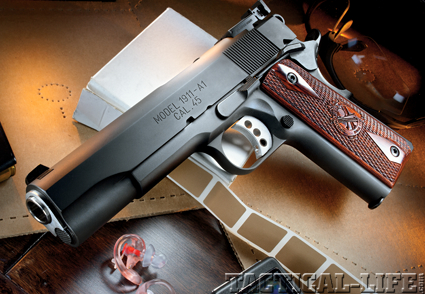The all-steel framed Springfield Armory Range Officer is a competition-ready 1911 straight from the factory, but still loaded with plenty of desirable custom features.
Recognizing that I am definitely in the minority when it comes to gun writers, I readily admit that I have not always been a 1911 shooter. That being said, I did start seriously shooting a variation of the 1911 design a few years ago in competition and that began a slow conversion for me to this style of pistol. The specific handgun that I have used to continue this journey is a Springfield Armory Range Officer. This isn’t my first experience with Springfield Armory, as I have carried their EMP for a while now. With that being said, I was then as I am now, duly impressed with the quality and workmanship of Springfield Armory 1911-style handguns.
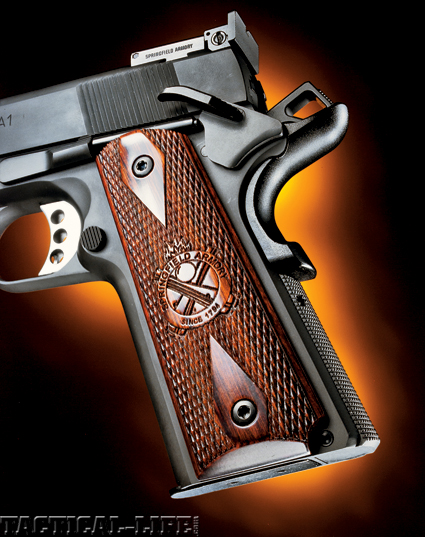
The high-ride beavertail, Delta hammer and checkered mainspring housing are all standard factory offerings on the Range Officer .45 ACP.
Advertisement — Continue Reading Below
Gun Details
The Range Officer is an all-steel version of their 5-inch single-stack 1911 .45 ACP pistol. Springfield has taken an already great 1911 handgun and made it a truly capable factory offering that any 1911 aficionado would be proud to own.
The Springfield 1911 platform is the perfect gun for the Range Officer package due to the company’s strict and rigid quality control and their unwavering dedication to “go the extra mile” for their customers. When I opened the signature blue Springfield Armory box containing the Range Officer, the first thing I saw was a black polymer holster and matching double magazine pouch packaged with the pistol. The holster and magazine pouches appear to be a quality continuation of the XD Gear line of accessories. Moving the factory paperwork out of the way revealed the handgun and one extra magazine.
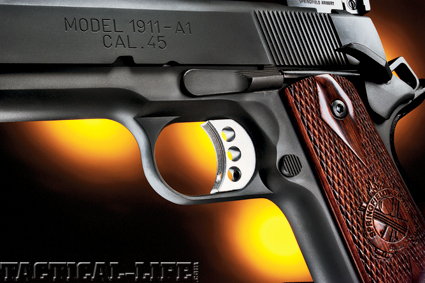
The pistol features a Videcki-style aluminum trigger and an extended combat safety.
Advertisement — Continue Reading Below
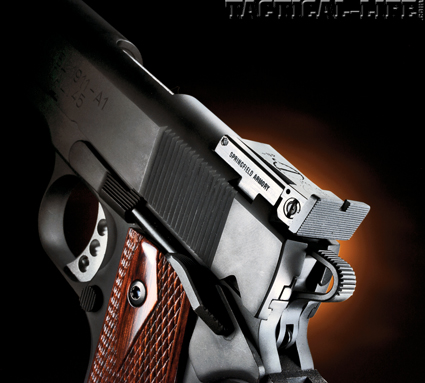
Springfield’s low-profile fully adjustable target rear sight was quick and easy to pick-up.
Taking the pistol out of the box immediately showed me what I was looking for, and what Springfield has done with the Range Officer is nothing short of amazing. No matter what the intended purpose of this gun is, from carry to competition, Springfield has left no stone unturned with this offering. Springfield has taken the Range Officer and finished the gun in what appears to be a matte, non-glare parkerizing but has used a stainless steel match-grade barrel and bushing, which makes for a nice contrast on the business end of the gun. Additionally, the pistol sports a very nice looking set of checkered wood grips with the Springfield logo on both sides. They also used torx-head grip screws that add a little touch of class and an all business look to the pistol.
The gun looks to have been built from the ground up with serious carry or competition in mind and would suit one well in either capacity. Magazine capacity is seven rounds and the magazines included with the pistol appear to be the same kind that most 1911s came with for years—in that they look like GI magazines. Weight is 40 ounces unloaded which is right in line with most other all-steel full-sized 1911-style handguns.
Advertisement — Continue Reading Below
Taking the gun apart and inspecting it before shooting it revealed no surprises for any student of the 1911-type platform and truly demonstrated the quality of the handgun. Working the action was as smooth as glass and the slide to frame fit was just right—not very much movement but not so tight as to cause a malfunction. One thing that I believe is overused on 1911s today is the full-length recoil spring guide rod, and this pistol has the standard recoil spring and plug with a regular length guide rod. Standard features on the Range Officer are a flared and lowered ejection port, flared magazine well, wide thumb safety, Delta hammer, beavertail grip safety with raised pad, low profile adjustable target sights, aluminum Videcki style trigger, standard stainless steel barrel and bushing for accuracy and a large polished feed ramp.
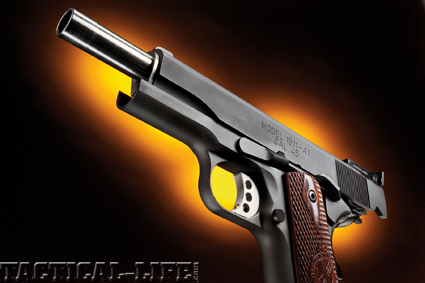 The Range Officer comes stock with a 5˝, stainless steel match-grade barrel.
The Range Officer comes stock with a 5˝, stainless steel match-grade barrel.
The Range Officer Model also offers a flat checkered mainspring housing straight from the factory. Last but not least, Springfield includes with this pistol the proprietary pistol lock contained in the mainspring housing and two keys to fit the lock as well as two Allen wrenches to aid in maintenance on the pistol.
Advertisement — Continue Reading Below
Range Time
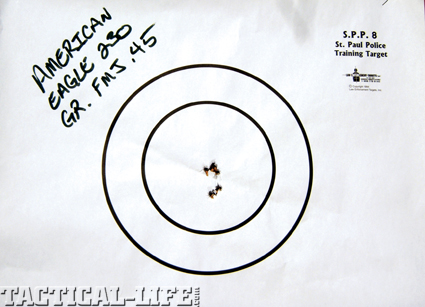
This 25-yard target proves the inherent accuracy of the Range Officer, with the American Eagle 230-gr. FMJ ammunition grouping at 1.50˝.
I was teaching a two-week Firearms Instructor Class with my good friend, fellow firearms instructor and IALEFI President Steve Johnson, and figured that would be the perfect time to run the Range Officer through its paces on the range. Steve and I, along with several students in the class, shot the gun with a variety of test ammunition. I used Winchester, Black Hills, Federal and CCI Blazer ammunition for the accuracy and velocity tests but I should mention that the gun ran flawlessly with every kind of .45 ACP ammunition I could find when doing the reliability testing. Two of the most impressive things about shooting this pistol were the inherent accuracy of the gun and the ultra reliability of the pistol. All together we ran about 450 to 500 rounds of ammunition through this gun with absolutely zero malfunctions.
I personally shot a 30-round combat course with this pistol and intentionally used a hodgepodge of various ammunition just to see what the gun would do. If a gun will have a problem functioning with commonly available ammunition, this is when it will normally hang up. How I did this was simply taking about 5 rounds of .45 ACP ammunition, including FMJ, and hollow points, from six different boxes and loading the magazines at random. I finished the course just as I started the course; with zero malfunctions and a clean 100% score on the target.
Advertisement — Continue Reading Below
Due to the all-steel construction, recoil was mild and easily managed by all shooters who used the pistol, no matter what ammunition was being used. Handling and ergonomics were great and all the controls were easy to manipulate. The grip safety with the raised pad made for a positive disengagement each time the grip was achieved and the manual safety was easily taken on and off with an audible click. The trigger broke at a clean 5 pounds and had very little take-up or overtravel at the onset or the follow through of the trigger press. The trigger actually felt a little lighter than 5 pounds to all of us who shot the gun, but the scale doesn’t lie.
The wood grips are a little thicker than what I am accustomed to feeling on a 1911 but felt really nice on the gun, filling the grip pretty well without being in the way. The beavertail and Delta hammer combination kept every person who shot the gun from getting any hammer bite, and the flat mainspring housing with nice 20 lines-per-inch checkering helped us all keep a firm grip on the pistol.
Some of the students in the class who shot the gun said that they didn’t like the sights very much because the sights are all black and were hard to see against some dark colored targets. I, on the other hand, was very pleased with the sight picture I was able to obtain with them. Both the front and rear sights have horizontal serrations to cut the glare and are the perfect height and width for defensive carry or competition use.
Advertisement — Continue Reading Below
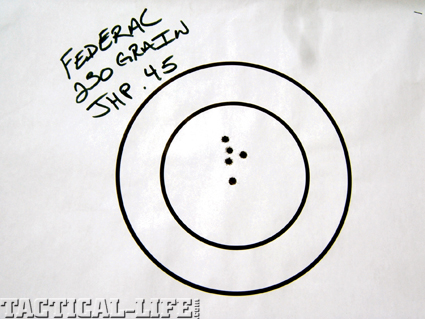
Due to the Range Officer’ s all-steel construction, recoil was mild and easily managed as this 2˝ group by Federal Hi-Shok 230-gr. JHP can attest.
All of the shooting I did for the accuracy testing on the gun was from the 25-yard line in a bench rest position. All groups were five shots at a time at individual targets. Other than one called flyer when my cellphone (set on vibrate) went off as I was breaking the shot, none of the groups were any larger than 3 inches. I was pleasantly surprised that one of the most economical brands of ammunition was the most accurate in the Range Officer, with American Eagle 230-grain FMJ printing at 1.5 inches for a five-shot group. Winchester was next with their 230-grain SXT line of hollow points printing at 1.75 inches for their five-shot group. Federal 230-grain Hi-Shok was next in line printing a 2-inch group, and Black Hills 185-grain JHP was close behind at 2.25 inches. The last kind of ammunition I checked in the Range Officer was a CCI offering of lead-free 230-grain FMJ ammo. Once again the pistol functioned flawlessly with this ammo, printing a five shot group at 3 inches.
I used a PACT Chronograph to check the velocity on the ammo while also shooting for accuracy. I took the average for the five rounds and used that as a good indicator of what kind of velocity the end user can expect from this ammunition in this pistol. Federal Hi-Shok produced an average of 852 feet per second (fps). Winchester SXT produced an average of 841 fps. CCI Blazer produced an average of 775 fps and Black Hills produced an average of 936 fps.
Advertisement — Continue Reading Below
Final Notes
From what I have gleaned from shooting, cleaning and inspecting this pistol, with the Range Officer 1911, Springfield Armory is offering an out-of-the-box competition ready 1911 handgun at an affordable price. The customer can use this pistol effectively, not only for CCW or home defense, but for any of the shooting sports disciplines out there today. The 5-pound trigger is perfectly acceptable for carry and defense work and can easily be fine-tuned by hundreds of gunsmiths to be a little lighter if the gun is to be a competition gun. I am the first to admit that I do not impress easily and this gun impressed me. Suffice it to say that this pistol performed and then some. If you are looking for an off-the-shelf 1911 that doesn’t need any work to be range ready then give some serious thought to a Springfield Armory Range Officer. Check it out for yourself at springfield-armory.com or call 800-680-6866.
